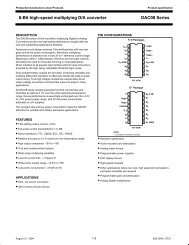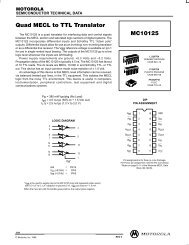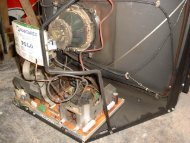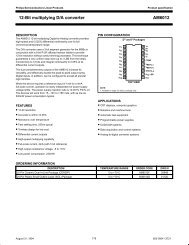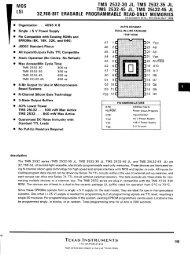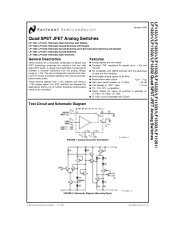AD561 Low Cost 10-Bit Monolithic D/A Converter - Analog Devices
AD561 Low Cost 10-Bit Monolithic D/A Converter - Analog Devices
AD561 Low Cost 10-Bit Monolithic D/A Converter - Analog Devices
You also want an ePaper? Increase the reach of your titles
YUMPU automatically turns print PDFs into web optimized ePapers that Google loves.
<strong>AD561</strong>S<strong>AD561</strong>TModel Min Typ Max Min Typ Max UnitsRESOLUTION <strong>10</strong> <strong>Bit</strong>s <strong>10</strong> <strong>Bit</strong>sACCURACY (Error Relative ±1/4 ±1/2 ±1/8 ±1/4 LSBto Full Scale) (0.025) (0.05) (0.012) (0.025) % of FS<strong>AD561</strong>DIFFERENTIAL NONLINEARITY ±1/2 ±1/4 ±1/2 LSBDATA INPUTSTTL, V CC = +5 V<strong>Bit</strong> ON Logic “1” +2.0 ** V<strong>Bit</strong> OFF Logic “0” +0.8 ** VCMOS, <strong>10</strong> V ≤ V CC ≤ 16.5 V<strong>Bit</strong> ON Logic “ 1 “ 70% V CC ** V<strong>Bit</strong> OFF Logic “0” 30% V CC ** VLogic Current (Each <strong>Bit</strong>) (T MIN to T MAX )<strong>Bit</strong> ON Logic “1” +20 +<strong>10</strong>0 ** ** nA<strong>Bit</strong> OFF Logic “0” –25 –<strong>10</strong>0 ** ** µAOUTPUTCurrentUnipolar 1.5 2.0 2.4 ** ** ** mABipolar ±0.75 ±1.0 ±1.2 ** ** ** mAResistance (Exclusive ofApplication Resistors) 40 M ** ΩUnipolar Zero (All <strong>Bit</strong>s OFF) 0.01 0.05 ** ** % of FSCapacitance 25 ** pFCompliance Voltage –2 –3 +<strong>10</strong> ** ** ** VSETTLING TIME TO 1/2 LSBAll <strong>Bit</strong>s ON-to-OFF or OFF-to-ON 250 ** nsPOWER REQUIREMENTSV CC , +4.5 V dc to +16.5 V dc 6 <strong>10</strong> ** ** mAV EE , –<strong>10</strong>.8 V dc to –16.5 V dc 11 16 ** ** mAPOWER SUPPLY GAIN SENSITIVITYV CC , +4.5 V dc to +16.5 V dc 2 <strong>10</strong> ** ** ppm of FS/%V EE , –<strong>10</strong>.8 V dc to –16.5 V dc 4 25 ** ** ppm of FS/%TEMPERATURE RANGEOperating –55 to +125 ** ** °CStorage –65 to +150 ** ** °CTEMPERATURE COEFFICIENTSWith Internal ReferenceUnipolar Zero 1 <strong>10</strong> 1 5 ppm of FS/°CBipolar Zero 2 20 2 <strong>10</strong> ppm of FS/°CFull Scale 15 60 15 30 ppm of FS/°CDifferential Nonlinearity 2.5 2.5 ppm of FS/°CMONOTONICITY Guaranteed Over Full Operating Guaranteed Over Full OperatingTemperature RangeTemperature RangePROGRAMMABLE OUTPUT 0 to +<strong>10</strong> ** VRANGES –5 to +5 ** VCALIBRATION ACCURACYFull-Scale Error with Fixed 25 ΩResistor ±0.1 ** % of FSBipolar Zero Error with Fixed <strong>10</strong> ΩResistor ±0.1 ** % of FSCALIBRATION ADJUSTMENTRANGEFull Scale (With 50 Ω Trimmer) ±0.5 ** % of FSBipolar Zero (With 50 Ω Trimmer) ±0.5 ** % of FSNOTES**Specifications same as <strong>AD561</strong>S specifications.Specifications subject to change without notice.REV. A–3–
<strong>AD561</strong>THE <strong>AD561</strong> OFFERS TRUE <strong>10</strong>-BIT RESOLUTION OVERFULL TEMPERATURE RANGEAccuracy: <strong>Analog</strong> <strong>Devices</strong> defines accuracy as the maximumdeviation of the actual, adjusted DAC output (see page 5) fromthe ideal analog output (a straight line drawn from 0 to FS – lLSB) for any bit combination. The <strong>AD561</strong> is laser trimmed to1/4 LSB (0.025% of FS) maximum error at +25°C for the Kand T versions – 1/2 LSB for the J and S.Monotonicity: A DAC is said to be monotonic if the outputeither increases or remains constant for increasing digital inputssuch that the output will always be a single-valued function of theinput. All versions of the <strong>AD561</strong> are monotonic over their fulloperating temperature range.Differential Nonlinearity: Monotonic behavior requires thatthe differential nonlinearity error be less than1 LSB both at +25°C and over the temperature range ofinterest. Differential nonlinearity is the measure of the variationin analog value, normalized to full scale, associated with a1 LSB change in digital input code. For example, for a <strong>10</strong> voltfull scale output, a change of 1 LSB in digital input code shouldresult in a 9.8 mV change in the analog output (1 LSB = <strong>10</strong> V× 1/<strong>10</strong>24 = 9.8 mV). If in actual use, however, a 1 LSB changein the input code results in a change of only 2.45 mV (1/4 LSB)in analog output, the differential nonlinearity error would be7.35 mV, or 3/4 LSB The <strong>AD561</strong>K and T have a max differentiallinearity error of 1/2 LSB.The differential nonlinearity temperature coefficient must alsobe considered if the device is to remain monotonic over its fulloperating temperature range. A differential nonlinearity temperaturecoefficient of 2.5 ppm/°C could, under worst case conditionsfor a temperature change of +25°C to +125°C, add 0.025%(<strong>10</strong>0 2.5 ppm/°C of error). The resulting error could then beas much as 0.025% + 0.025% = 0.05% of FS (1/2 LSB represents0.05% of FS). To be sure of accurate performance all versions ofthe <strong>AD561</strong> are therefore <strong>10</strong>0% tested to be monotonic over thefull operating temperature range.Figure 1. Chip Bonding DiagramCONNECTING THE <strong>AD561</strong> FOR BUFFERED VOLTAGEOUTPUTThe standard current-to-voltage conversion connections usingan operational amplifier are shown here with the preferredtrimming techniques. If a low offset operational amplifier(AD5<strong>10</strong>, AD741L, AD301AL) is used, excellent performancecan be obtained in many situations without trimming. (A 5 mVop amp offset is equivalent to 1/2 LSB on a <strong>10</strong> volt scale.) If a25 Ω fixed resistor is substituted for the 50 Ω trimmer, unipolarzero will typically be within ±1/<strong>10</strong> LSB (plus op amp offset),and full scale accuracy will be within ±1 LSB. Substituting a25 Ω resistor for the 50 Ω bipolar offset trimmer will give abipolar zero error typically within ±1 LSB.The AD509 is recommended for buffered voltage-outputapplications that require a settling time to ±1/2 LSB of onemicrosecond. The feedback capacitor is shown with theoptimum value for each application; this capacitor is required tocompensate for the 25 picofarad DAC output capacitance.ORDERING GUIDEACCURACY GAIN T C PACKAGEMODEL 1 TEMP RANGE @ +25C (of FS/C) OPTION 2<strong>AD561</strong>JD 0°C to +70°C ±1/2 LSB max 80 ppm max D-16<strong>AD561</strong>JN 0°C to +70°C ±1/2 LSB max 80 ppm max N-16<strong>AD561</strong>KD 0°C to +70°C ±1/4 LSB max 30 ppm max D-16<strong>AD561</strong>KN 0°C to +70°C ±1/4 LSB max 30 ppm max N-16<strong>AD561</strong>SD –55°C to +125°C ±1/2 LSB max 60 ppm max D-16<strong>AD561</strong>TD –55°C to +125°C ±1/4 LSB max 30 ppm max D-16<strong>AD561</strong>/883B –55°C to +125°C * * *PIN CONFIGURATIONTOP VIEWNOTES1 For details on grade and package offerings screened in accordance with MIL-STD-883, refer to the<strong>Analog</strong> <strong>Devices</strong> Military Products Databook or current <strong>AD561</strong>/883B data sheet.2 D = Ceramic DIP; N = Plastic DIP.*Refer to <strong>AD561</strong>/883B military data sheet.–4– REV. A
<strong>AD561</strong>UNIPOLAR CONFIGURATIONThis configuration, shown in Figure 2, will provide a unipolar0 V to +<strong>10</strong> V output range.STEP I . . . ZERO ADJUSTTurn all bits OFF and adjust op amp trimmer, R 1 , until theoutput reads 0.000 volts (1 LSB = 9.76 mV).STEP 11. . . GAIN ADJUSTTurn all bits ON and adjust 50 Ω gain trimmer, R 2 , until theoutput is 9.990 volts. (Full scale is adjusted to 1 LSB less thannominal full scale of <strong>10</strong>.000 volts.) If a <strong>10</strong>.23 V full scale is desired(exactly <strong>10</strong> mV/bit), insert a 120 Ω resistor in series with R 2 .BIPOLAR CONFIGURATIONThis configuration, shown in Figure 3, will provide a bipolaroutput voltage from –5.000 to +4.990 volts, with positive fullscale occurring with all bits ON (all 1s).STEP 1. . . ZERO ADJUSTTurn ON MSB only, turn OFF all other bits. Adjust 50 Ωtrimmer R 3 , to give 0.000 output volts. For maximum resolutiona 120 Ω resistor may be placed in parallel with R 3 .STEP 11. . . GAIN ADJUSTTurn OFF all bits, adjust 50 Ω gain trimmer to give a reading of–5.000 volts.Please note that it is not necessary to trim the op amp to obtainfull accuracy at room temperature. In most bipolar situations,the op amp trimmer is unnecessary unless the untrimmed offsetdrift of the op amp is excessive.<strong>10</strong> VOLT BUFFERED BIPOLAR OUTPUTThe <strong>AD561</strong> can also be connected for a ±<strong>10</strong> volt bipolar rangewith an additional external resistor as shown in Figure 4. Alarger value trimmer is required to compensate for tolerance inthe thin film resistors, which are trimmed to match the full-scalecurrent. For best full scale temperature coefficient performance,the external resistors should have a TC of –50 ppm/°C.CIRCUIT DESCRIPTIONA simplified schematic with the essential circuit features of the<strong>AD561</strong> is shown in Figure 5. The voltage reference, CR1, is aburied Zener (or subsurface breakdown diode). This deviceexhibits far better all-around performance than the NPN baseemitterreverse-breakdown diode (surface Zener), which is innearly universal use in integrated circuits as a voltage reference.Greatly improved long-term stability and lower noise are themajor benefits the buried Zener derives from isolating thebreakdown point from surface stress and mobile oxide chargeeffects. The nominal 7.5 volt device (including temperaturecompensation circuitry) is driven by a current source to thenegative supply so the positive supply can be allowed to drop aslow as 4.5 volts. The temperature coefficient of each diode isindividually determined; this data is then used to laser trim acompensating circuit to balance the overall TC to zero. Thetypical resulting TC is 0 to ±15 ppm/°C. The negative referencelevel is inverted and scaled by A 1 to give a +2.5 volt reference,which can be driven by the low positive supply. The <strong>AD561</strong>,packaged in the 16-pin DIP, has the +2.5 volt reference (REFOUT) connected directly to the input of the control amplifier(REF IN). The buffered reference is not directly availableexternally except through the 2.5 kΩ bipolar offset resistor.Figure 2. 0 V to +<strong>10</strong> V Unipolar Voltage OutputFigure 3. ±5 V Buffered Bipolar Voltage OutputFigure 4. ±<strong>10</strong> V Buffered Voltage OutputThe 2.5 kΩ scaling resistor and control amplifier A 2 then force a1 mA reference current to flow through reference transistor Q 1 ,which has a relative emitter area of 8A. This is accomplished byforcing the bottom of the ladder to the proper voltage. Since Q 1and Q 2 have equal emitter areas and equal 5 kΩ emitter resistors,Q 2 also carries 1 mA. The ladder voltage drop constrains Q 7(with area 4A) to carry only 0.5 mA; Q 8 carries 0.25 mA, etc.The first four significant bit cells are exactly scaled in emitterarea to match Q 1 for optimum V BE and V BE drift match, as wellas for beta match. These effects are insignificant for the lowerorder bits, which account for a total of only 1/16 of full scale.However, the 18 mV V BE difference between two matchedtransistors carrying emitter currents in a ratio of 2:1 must becorrected. This is achieved by forcing 120 µA through the150 Ω interbase resistors. These resistors, and the R-2R ladderresistors, are actively laser-trimmed at the wafer level to bringtotal device accuracy to better than 1/4 LSB. Sufficient ratioaccuracy in the last two bits is obtained by simple emitter areaREV. A–5–
<strong>AD561</strong>Figure 5. Circuit Diagram Showing Reference, Control Amplifier, Switching Cell, R-2R Ladder, and <strong>Bit</strong> Arrangementof <strong>AD561</strong>ratio such that it is unnecessary to use additional area for ladderresistors. The current in Q 16 is added to the ladder to balance itproperly, but is not switched to the output; thus, full scale is<strong>10</strong>23/<strong>10</strong>24 2 mA.The switching cell of Q 3 , Q 4 , Q 5 and Q 6 serves to steer the cellcurrent either to ground (BIT 1 low) or to the DAC output(BIT 1 high). The entire switching cell carries the same currentwhether the bit is on or off, minimizing thermal transients andground current errors. The logic threshold, which is generatedfrom the positive supply (see Digital Logic Interface), is appliedto one side of each cell.Figure 6. Digital Threshold vs. Positive SupplyDIGITAL LOGIC INTERFACEAll standard positive supply logic families interface easily withthe <strong>AD561</strong>. The digital code is positive true binary (all bitshigh, Logic “1,” gives positive full scale output). The logic inputload factor (<strong>10</strong>0 nA max at Logic “1,” –25 µA max at Logic “0,”3 pF capacitance), is less than one equivalent digital load for alllogic families, including unbuffered CMOS. The digitalthreshold is set internally as a function of the positive supply, asshown in Figure 6. For most applications, connecting V CC to thepositive logic supply will set the threshold at the proper level formaximum noise immunity. For nonstandard applications, referto Figure 6 for threshold levels. Uncommitted bit input lineswill assume a “1” state (similar to TTL), but they are highimpedance and subject to noise pickup. Unused digital inputsshould be directly connected to ground or V CC , as desired.SETTLING TIMEThe high speed NPN current steering switching cell andinternally compensated reference amplifier of the <strong>AD561</strong> arespecifically designed for fast settling operation. The typicalsettling time to ±0.05% (1/2 LSB) for the worst case transition(major carry, 0111111111 to <strong>10</strong>00000000) is less than 250 ns;the lower order bits all settle in less than 200 ns. (Worst casesettling occurs when all bits are switched, especially the MSB.)Full realization of this high speed performance requires strictattention to detail by the user in all areas of application andtesting.The settling time for the <strong>AD561</strong> is specified in terms of thecurrent output, an inherently high speed DAC operating mode.However, most DAC applications require a current-to-voltageconversion at some point in the signal path, although anunbuffered voltage level (not using an op amp) is suitable foruse in a successive-approximation A/D converter (see page 8),or in many display applications. This form of conversion cangive very fast operation if proper design and layout is done. Thefastest voltage conversion is achieved by connecting a low valueresistor directly to the output, as shown in Figure 9. In this case,the settling time is primarily determined by the cell switchingtime and by the RC time constant of the <strong>AD561</strong> output capacitanceof 25 picofarads (plus stray capacitance) combined with theoutput resistor value. Settling to 0.05% of full scale (for a fullscaletransition) requires 7.6 time constants. This effect isimportant for R > 1 kΩ.If an op amp must be used to provide a low impedance outputsignal, some loss in settling time will be seen due to op ampdynamics. The normal current-to-voltage converter op ampcircuits are shown in the applications circuits on page 5, usingthe fast settling AD509. The circuits shown settle to ±1/2 LSBin 600 ns unipolar and 1.1 µs bipolar. The DAC outputcapacitance, which acts as a stray capacitance at the op ampinverting input, must be compensated by a feedback capacitor,as shown. The value should be carefully chosen for eachapplication and each op amp type.–6– REV. A
<strong>AD561</strong>Fastest operation will be obtained by minimizing lead lengths,stray capacitance and impedance levels. Both supplies should bebypassed near the devices; 0.1 µF will be sufficient since the<strong>AD561</strong> runs at constant supply current regardless of input code.POWER SUPPLY SELECTIONThe <strong>AD561</strong> will operate over a wide range of power supplyvoltages, with a total supply from 15.3 to 33 volts. Symmetricalsupplies are not required, and in many applications not recommended.Maximum allowable supplies are ±16.5 V.The positive supply level determines the digital threshold level,as explained on page 6 and shown in Figure 6. It is thereforerecommended that V CC be connected directly to the digitalsupply for best threshold match.Positive output voltage compliance range is unaffected by thepositive supply level because of the open collector output stagedesign; thus the full +<strong>10</strong> volt compliance is available even with a+5 volt V CC level. Power supply rejection is excellent, so thatdigital supply noise will not be reflected to the output. but useof a 0.1 µF bypass capacitor near the <strong>AD561</strong> is recommendedfor decoupling.The nominal negative supply level is –15 volts, with an allowablerange of –<strong>10</strong>.8 to –16.5 volts. The negative supply levelaffects the negative compliance range, as shown in Figure 7.OUTPUT VOLTAGE COMPLIANCEThe <strong>AD561</strong> has a typical output compliance range from –3 to+<strong>10</strong> volts. The output current is unaffected by changes in theoutput terminal voltage over that range. This results from theuse of open collector output switching stages in a cascadeconfiguration, and gives an output impedance of 40 MΩ.Positive compliance range is limited only by collector breakdown(and is independent of positive supply level), but thenegative range is limited by the required bias levels and resistorladder voltage. Negative compliance varies with negative supply,as shown in Figure 7. The compliance range is guaranteed to be–2 to +<strong>10</strong> volts with V EE = –15 volts.REV. AFigure 7. Typical Negative Compliance Range vs.Negative SupplyDIRECT UNBUFFERED VOLTAGE OUTPUTThe wide compliance range allows direct current-to-voltageconversion with just an output resistor. Figure 8 shows aconnection using the gain and bipolar output resistors to give a±1.66 volt bipolar swing. In this situation, the digital code iscomplementary binary. Other combinations of internal andexternal output resistors (R X ) can be used to scale to alternatevoltage ranges, simply by appropriately scaling the 0 to –2 mAunipolar output current and using the 2.5 volt reference voltage–7–for bipolar offset. For example, setting R X = 2.5 kΩ gives a ±1volt range with a 1 kΩ equivalent output impedance. A 0 to +<strong>10</strong>volt output can be obtained by connecting the 5 kΩ gain resistorto 9.99 volts; again the digital code is complementary binary.Figure 8. Unbuffered Bipolar Voltage OutputHIGH SPEED <strong>10</strong>-BIT A/D CONVERTERSThe fast settling characteristics of the <strong>AD561</strong> make it ideal forhigh speed successive approximation A/D converters. Theinternal reference and trimmed application resistors allow a<strong>10</strong>-bit converter system to be constructed with a minimum partscount. Shown here is a configuration using standard components;this system completes a full <strong>10</strong>-bit conversion in 5.5 µsunipolar or 12 µs bipolar. This converter will be accurate to±1/2 LSB of <strong>10</strong> bits and have a typical gain TC of <strong>10</strong> ppm/°C.In the unipolar mode, the system range is 0 to 9.99 volts,with each bit having a value of 9.76 mV. For true conversionaccuracy, an A/D converter should be trimmed so that a givenbit code output results from input levels from 1/2 LSB below to1/2 LSB above the exact voltage which that code represents.Therefore, the converter zero point should be trimmed with aninput voltage of +4.9 mV; trim R 1 until the LSB just begins toappear in the output code (all other bits “0”). For full scale, usean input voltage of +9.985 volts (<strong>10</strong> volts – 1 LSB – 1/2 LSB);then trim R 2 again until the LSB just begins to appear (all otherbits “1”).The bipolar signal range is –5.0 to +4.99 volts. Bipolar offsettrimming is done by applying a +4.9 mV input signal andtrimming R 1 for the LSB transition (MSB “1,” all other bits“0.”) Full scale is set by applying –4.995 volts and trimming R 2for the LSB transition (all other bits “0”). In many applications,the pretrimmed application resistors are sufficiently accuratethat external trimmers will be unnecessary, especially insituations requiring less than full <strong>10</strong>-bit ± 1/2 LSB accuracy.For fastest operation, the impedance at the comparator summingnode must be minimized, as mentioned in the section onsettling time. However, lowering the impedance will reduce thevoltage signal to the comparator (at an equivalent impedance of1 kΩ, 1 LSB = 2 mV) to the point that comparator performancewill be sacrificed. A 1 kΩ resistor is the optimum value for thisapplication for <strong>10</strong>-bit accuracy. The chart shown in the figuregives the speed of the ADC for ±1/2 LSB accuracy (and nomissing codes) for 6-, 8- and <strong>10</strong>-bit resolution.
<strong>AD561</strong>circuit will not produce both 1 to 5 volt and4-to-20 mA outputs simultaneously.)C394e–1–5/97Figure <strong>10</strong>. Digital 4-to-20 mA or 1-to-5 Volt Line DriverFigure 9. Fast Precision <strong>Analog</strong> to Digital <strong>Converter</strong>A much faster converter can be constructed by using higherperformance external components. Each individual high-orderbit settles in less than 250 ns; the low-order bits in less than200 ns. Because of this, a staged clock, which speeds up forlower bits will improve the speed. Also, a faster comparator andSchottky TTL or ECL logic would be necessary. <strong>10</strong>-bit convertersin the 3 µs to 5 µs range could be built around the <strong>AD561</strong>with these techniques.DIGITAL 4-TO-20 mA OR 1-TO-5 VOLT CONVERTERA direct digital 4-to-20 mA or 1-to-5 volt line driver can be builtwith the <strong>AD561</strong> as shown in Figure <strong>10</strong>. The 2.5 volt reference isdivided to provide 1 volt at the op amp noninverting input – thus azero input code results in a 1 volt output at the Darlington emitter(V OUT ). The 2 k feedback resistance converts the nominal 2 mA(± 20%) full-scale output from the <strong>AD561</strong> to 4 volts, for atotal output of 5 volts FS. The voltage at the emitter forces aproportional current through the 250 Ω (which appears at thecollector as I OUT ) The <strong>AD561</strong> current is added to the 4–20 mAline; thus 5 volts full scale gives 22 mA in the current loop. Forexactly 20 mA, trim the 1 k pot for 4.5 V FS. (A single op ampDIGITALLY PROGRAMMABLE SETPOINTCOMPARATORFigure 11 demonstrates a high accuracy systems-orientedsetpoint comparator. The 2.5 volt reference is buffered andamplified by the AD741K to produce an exact <strong>10</strong>.000 voltreference which could be used as a primary system reference forseveral such circuits. The +<strong>10</strong> volt compliance of the <strong>AD561</strong>then allows it to generate a zero to +<strong>10</strong> volt output swingthrough the 5 kΩ application resistor without an additional opamp. The digital code for this system will be complementarybinary (all 1s give 0.00 volts out).Figure 11. Digitally Programmable Set-Point ComparatorOUTLINE DIMENSIONSDimensions shown in inches and (mm).16-Pin Ceramic PackageD-1616-Pin Plastic PackageN-16PRINTED IN U.S.A.–8– REV. A




